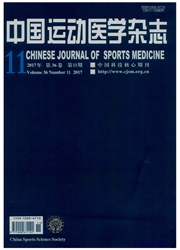

 中文摘要:
中文摘要:
目的:观察耐力运动训练对骨骼肌卫星细胞线粒体能量代谢的影响,并探讨其对成肌分化的调控机制。方法:C57BL/6小鼠随机分为安静对照组(N组)和运动训练组(T组)。12周训练后,两步酶消化法分离骨骼肌卫星细胞,免疫化学染色鉴定卫星细胞纯度。原代培养并体外诱导成肌分化,倒置显微镜观察卫星细胞成肌分化程度。分别在分化0h和24h测定线粒体呼吸功能、ATP合成活力、膜电位和MyHC、COXⅣ、AMPK、p-AMPK、p21蛋白表达量。结果:免疫化学染色显示desmin阳性细胞〉90%,表明获取的卫星细胞纯度高。HE染色结果显示T组腓肠肌肌纤维横截面积显著高于N组(P〈0.05)。分化0h时,T组态3呼吸速率(ST3)、呼吸控制比(RCR)、线粒体ATP合成活力、p21表达较N组显著升高(P〈0.05),P—AMPK表达显著降低(P〈0.05)。分化24h时,T组肌管形成数量及MyHC表达较N组显著升高(P〈0.05),ST3、RCR、ATP合成活力、膜电位、p21及COXIV表达显著增加(P〈0.05),P—AMPK表达显著降低(P〈0.05)。结论:耐力运动训练可提高未分化卫星细胞线粒体能量代谢水平.继而抑制AMPK活化而增加p21表达,从而促进成肌分化的启动和进程。
 英文摘要:
英文摘要:
Objective To observe the effect of endurance exercise on the mitochondrial bioenergetic metabolism in skeletal muscle satellite cells and its effect on the myogenesis. Methods C57BL/6 mice were randomly divided into two groups: normal control group (N) and exercise training group (T). The animals in group T exercised on a treadmill for 12 weeks. Purified satellite cells were obtained and im- munohistochemical staining was employed to identify the satellite cells cultured in vitro. Differentiation was induced by changing the growth medium and observed by inverted microscopy. At 0 and 24 h of differentiation,mitochondrial respiration parameters,ATP synthetase activity,mitochondrial membrane potential (A~),MyHC, COXIV ,AMPK, p-AMPK, and p21 protein expression were measured. Results Comparing with group N, at 0 h of differentiation, ST3, RCR, ATP synthesis activity, and p21 protein ex- pression dramatically increased(P 〈 0.05), and p-AMPK protein expression significantly decreased(P 〈 0.05) in group T. At 24 h of differentiation, comparing with group N, the formation of myotubes and ex- pression of MyHC markedly increased in group T (P 〈 0.05). In addition,ST3,RCR,and ATP synthesis activities, A~,p21 ,and COX IV protein expression showed significantly enhanced (P 〈 0.05),and p- AMPK protein expression significantly diminished (P 〈 0.05). Conclusion Endurance exercise markedly promotes the mitochondrial bioenergetic metabolism,which in turn enhances the myogenic differentiation through inactivation of AMPK and up-regulation of p21.
 同期刊论文项目
同期刊论文项目
 同项目期刊论文
同项目期刊论文
 期刊信息
期刊信息
